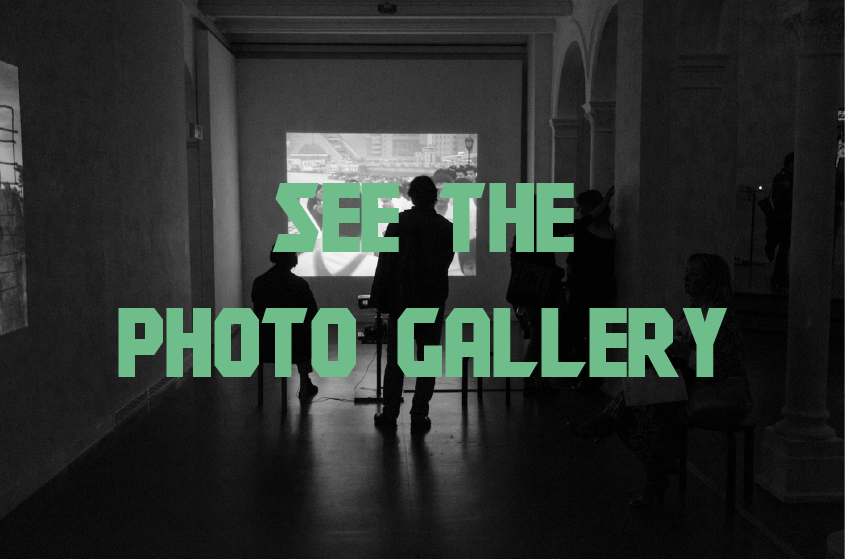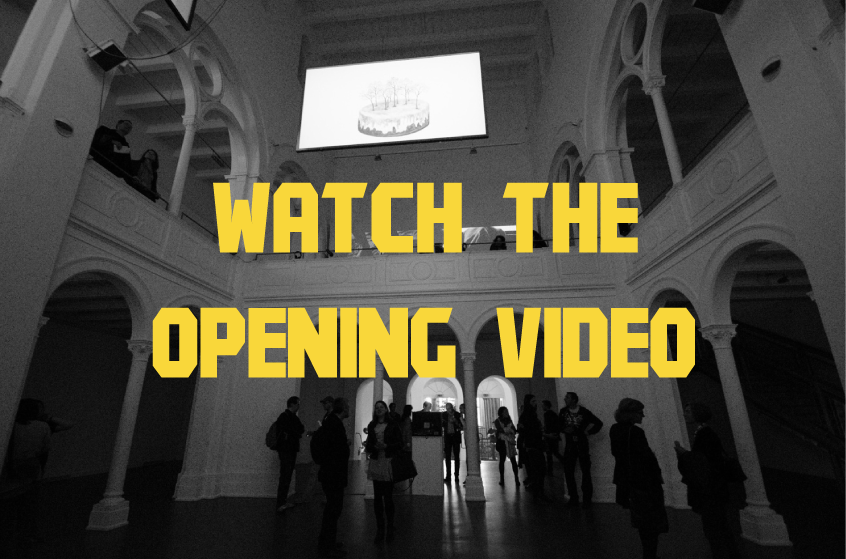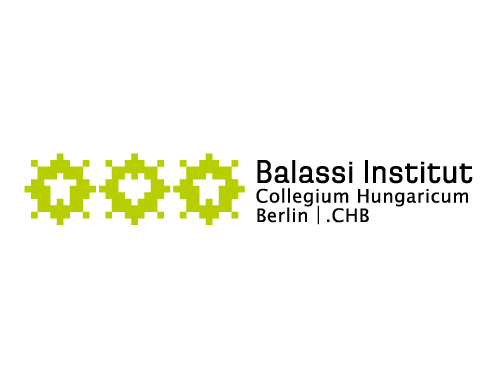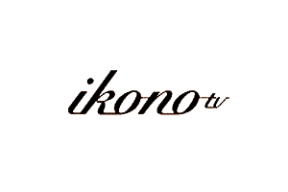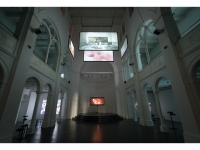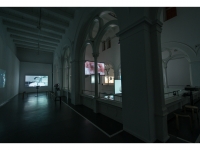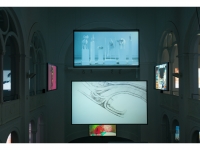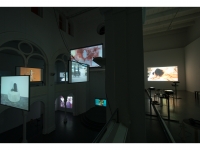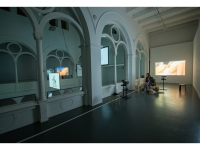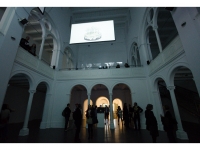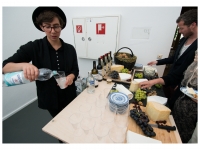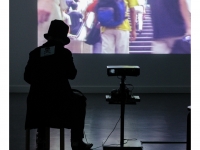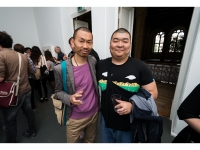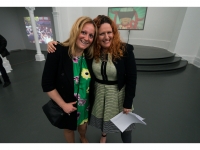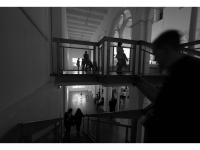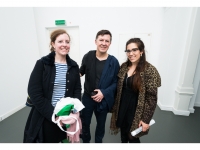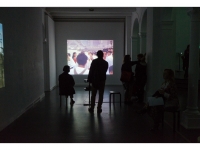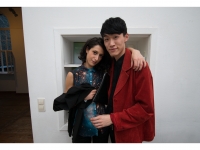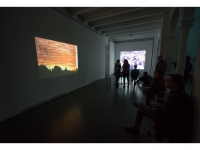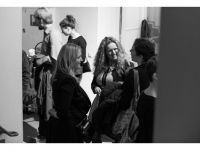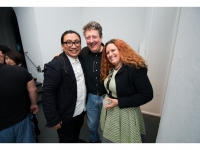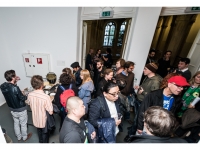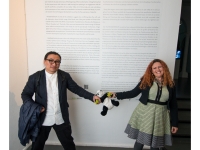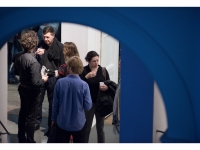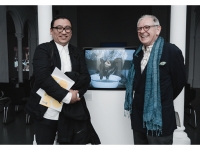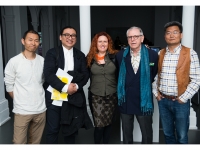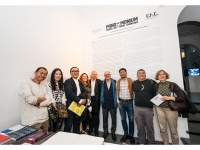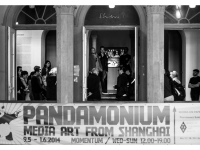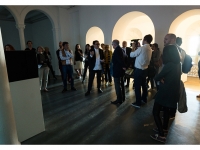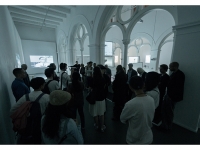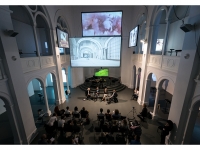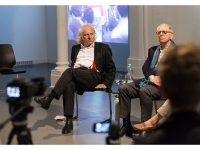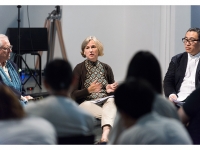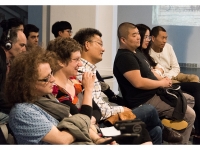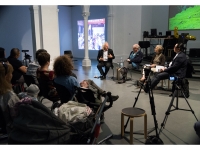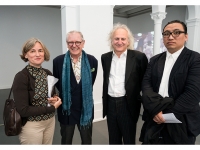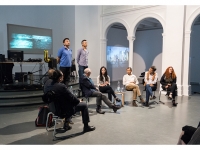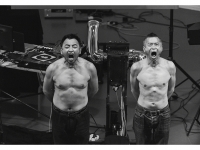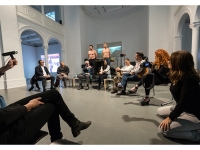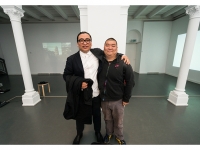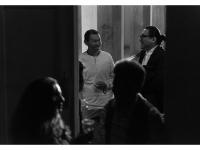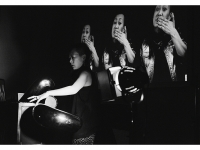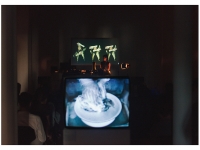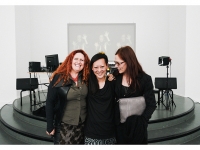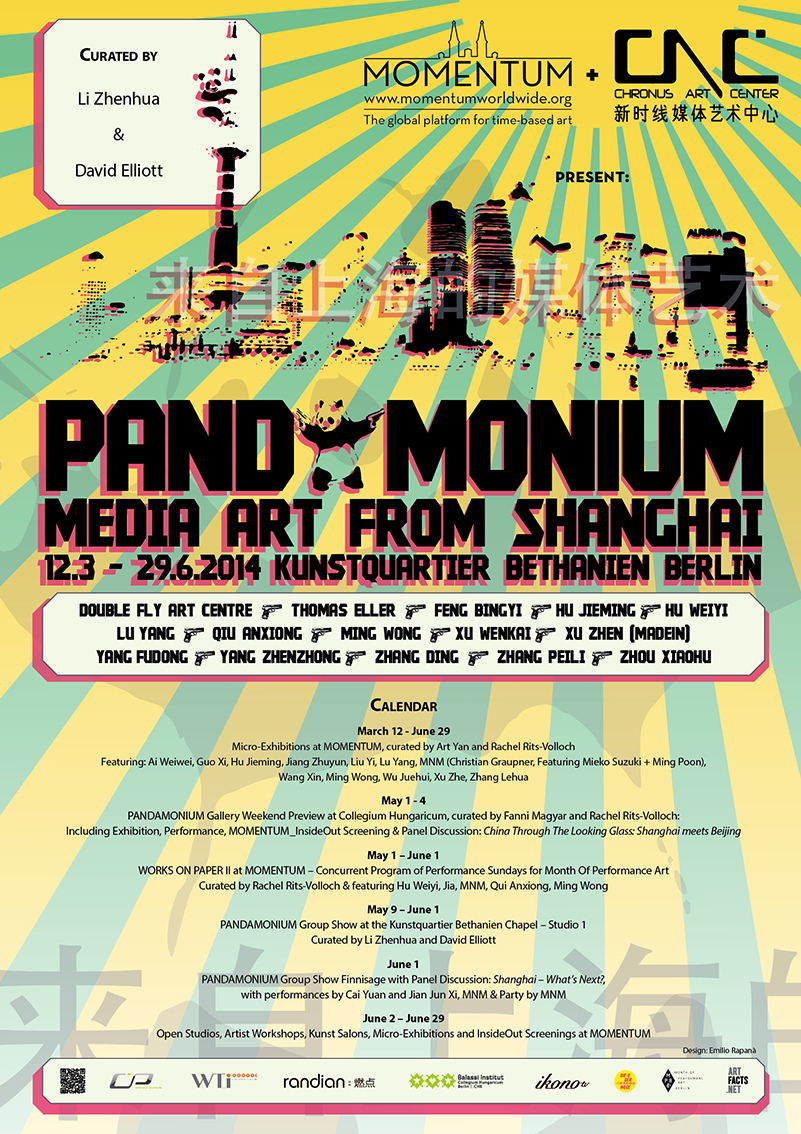
PANDAMONIUM
MEDIA ART FROM SHANGHAI
A Collaboration Between CAC | CHRONUS ART CENTER Shanghai and MOMENTUM Berlin
12 MARCH – 29 JUNE 2014
A Series of Artist Residencies, Open Studios, Micro-Exhibitions, Kunst Salons, Parties, Provocations, and a Group Exhibition
Curated by Li Zhenhua, David Elliott, and Rachel Rits-Volloch
 |
March 12 – June 29:
Artist Residencies, Open Studios, Micro-Exhibitions, Kunst Salons.
Micro-Exhibitions at MOMENTUM Curated by Art Yan and Rachel Rits-Volloch
May 1 – 4:
PANDAMONIUM Gallery Weekend Preview
at Collegium Hungaricum Berlin
Curated by Fanni Magyar and Rachel Rits-Volloch:
Including Exhibition, Performance, MOMENTUM InsideOut Program
& Panel Discussion: China Through The Looking Glass: Shanghai Meets Beijing
May 1 – June 1:
WORKS ON PAPER II at MOMENTUM
Concurrent Program of Performance Sundays for Month Of Performance Art
Curated by Rachel Rits-Volloch
May 9 – June 1:
PANDAMONIUM Group Show at the Kunstquartier Bethanien Chapel – Studio 1
Curated by Li Zhenhua and David Elliott
June 1:
PANDAMONIUM Group Show Finnisage
Including: Curators’ Guided Tour, Symposium, Performances and final party by MNM with DJ Mieko Suzuki
June 2 – June 29:
Open Studios, Artist Workshops, Kunst Salons, Micro-Exhibitions at MOMENTUM
|
READ HERE THE PANDAMONIUM DOSSIER
|
 |
CURATORIAL STATEMENT
Since China Avant-garde, with its iconic German debut at Berlin’s Haus der Kulturen der Welt in 1993, Chinese contemporary art has shown a completely new face to the contemporary art world. After 1979, when the first avant-garde art groups showed their work after the Cultural Revolution, Chinese art has undergone a transformation from demanding artistic freedoms to a more complex and nuanced response to both its domestic and global context. This year marks the 35-year anniversary of the beginning of this transformation.
Zhang Peili started his first experiments with video art in 1988, moving from painting to an engagement with the specific aesthetics and politics of new media. Video art in China today not only contributes to the mainstream of new media art and aesthetics, but has also rooted itself deeply in practical research into technological development as well as into the experience of daily life.
PANDAMONIUM, the title of this exhibition, suggests two conflicting ideas: the soft, cuddly, diplomatic, almost clichéd, image of the Panda, one of the great symbols of China to the outside world, and the wild, fertile, noisy disorder of Pandemonium, the place of all demons in Milton’s ‘Paradise Lost’. The birth of this new word represents the chaotic energy of Chinese artists’ efforts and experiments in new media art over the past decade. Furthermore, it highlights the fact that Chinese contemporary art has not yet, other than through the art market, engaged globally during this time. This lack has been veiled by the speed of Chinese social and economic development and further masked by the impact of politics and the media.
PANDAMONIUM focuses on the work of Shanghai artists who create openly, distant from the country’s political center in Beijing. The group of artists shown here are all engaged in experiments with new media, introducing into Chinese art new creative ideas and aesthetic approaches. This exhibition addresses the first three generations of media artists in China. Starting with pioneers like Zhang Peili and Hu Jieming, working since the 1980s to break new ground with the technologies of media art, to the successes of the next generation, such as internationally acclaimed artist Yang Fudong, and moving on to their students, who are developing their own visual languages in response and in contrast to their pioneering teachers. Most of the works of this youngest generation of artists is premiered in Berlin for the first time. Berlin-based artists Thomas Eller and Ming Wong, both with strong links to China, present works responding to these themes.
Focusing on single-channel video, the work selected for this show presents minimal and subtle expressions that offer a view not only of some of the strongest work now being made in Shanghai but also of the scale of transformation that is now running through the whole of Chinese contemporary art. PANDAMONIUM is especially proud to premiere a new work by Qiu Anxiong, made for this exhibition.
* Special thanks for support from CAC | Chronus Art Center, WTI and CP, and also to the .CHB Collegium Hungaricum Berlin.
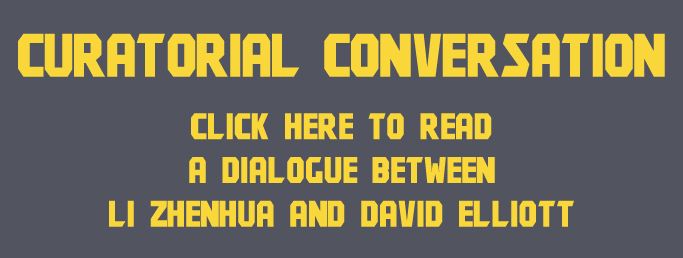
FEATURING
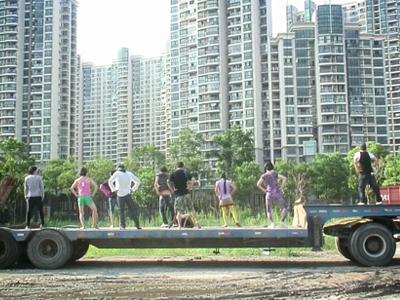
DOUBLE FLY ART CENTER
CV – Website
Double Fly Art Center is a 9-member art collective which was formed in 2008 after all its members graduated from the New Media Department of the China Academy of Fine Arts in Hangzhou, having studied under Zhang Peili. Working across media as diverse as performance, video games, music videos, painting, and video art, they remain irreverent and anarchic in their critique of social norms in China, as well as of the international art market. Double Fly Art Center members now live predominantly in Hangzhou, Shanghai and Beijing and work collectively as well as individually. Recent exhibitions of their work include SEE/SAW: COLLECTIVE PRACTICE IN CHINA NOW (2012) and ON | OFF: CHINA’S YOUNG ARTISTS IN CONCEPT AND PRACTICE (2013) at Ullens Center for Contemporary Art in Beijing and a solo-show at the Vanguard Gallery in Shanghai (2012). Their work has never before been shown in Berlin.
Contemporary Business, 2013
In Contemporary Business, the members of Double Fly Art Center, a Shanghai-based collective, parodies a catchy Mandarin pop song, Love Business (Ai Qing Mai Mai), singing and dancing before a handheld video camera. Contemporary Business is part music video and part low-budget YouTube clip, at times revealing carefully choreographed moves and at others a snapshot of informal and seemingly spontaneous moments. The members of Double Fly dance and sing their way across Shanghai, singing about penises, breasts, and sexual encounters in one verse while deriding the artistic and curatorial limitations placed on them by an unidentified authority in the next. The backdrops in Contemporary Business seem carefully chosen to reflect upon Shanghai’s and China’s complicated past, its rapid present transformations, and its undecided future, as the merry band of outsiders groove in front of a massive, drab communist style housing project, dance on the Bund along Shanghai’s Huangpu River, a vibrant promenade lined with handsome Neo-Classical, Beaux-Arts and Art-Deco buildings (former banks and financial houses from the 19th and early 20th centuries) that are beautiful relics of Shanghai’s colonial past and emblems of the city’s cosmopolitan present.
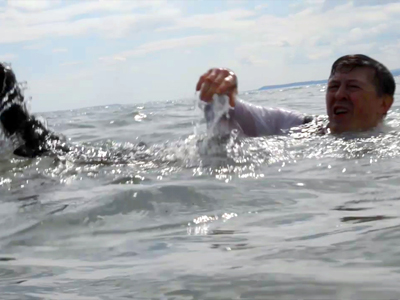
Thomas Eller (b. 1964) is a German visual artist, curator, and writer based in Berlin. In 2004 he founded the online magazine Artnet China, and in 2008 was the artistic director of the Temporäre Kunsthalle, Berlin. Thomas Eller is the curator of Die 8 der Wege, the exhibition of art from Beijing running concurrently with PANDAMONIUM. For PANDAMONIUM he shows work responding to themes and influences from China.
The white male complex, #5 (lost), 2014
Shot on Lampedusa in 2014, on the beach infamous for its migrant traffic, Eller lives the plight of so many who wash up on that shore. Eternally looping at the cusp of life and death, this work leaves the viewer feeling oddly complicit in one man’s surreal struggle. Yet while one white man submerged in a suit is surreal, thousands of African migrants are our reality. Like Isaac Julien’s 2010 work Ten Thousand Waves, on the deaths of Chinese migrant cockle pickers on the shores of the UK, Eller in his own language tackles the watery deaths of migrant workers as a sadly universal suffering, devoid of markers of place or time.
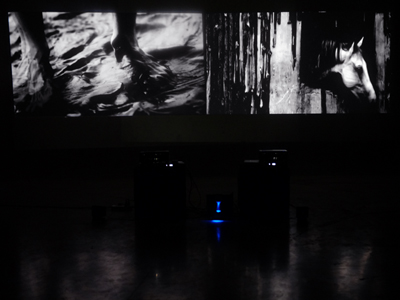
Feng Bingyi (b. 1991, Ningbo) is a young emerging talent in the Chinese art scene. Having studied under Yang Fudong at the China Academy of Art, she follows in his footsteps with her focus on cinematic traditions, while employing a poetic language. Distancing herself from the chains of external reality, she looks for inspiration within her internal impressions, which she expresses in the form of installations, photography, documentary and animation. After receiving both the Outstanding Graduation Work Award and the China Academy of Art Scholarship from the China Academy of Fine Arts in Hangzhou in 2013, Feng continued her studies at the Chelsea College of Art and Design, University of the Arts in London in 2014. Though she has been exhibited in China alongside well-established contemporary artists, she has never before been shown in Berlin. Feng is one of the artists undertaking the PANDAMONIUM Residency.
The Undertow, 2012
In this black and white split-screen video, the earthiness from the movement of mud as bare feet tamper at it and of the texture of a horse’s pelt as it breathes, contrast with the digitized sound-samples that are laid over the thick blacks and greys of the imagery. In Feng’s reposed, poetic style, The Undertow creates a liminal, ambiguous space, which the viewer is impelled to fill in.
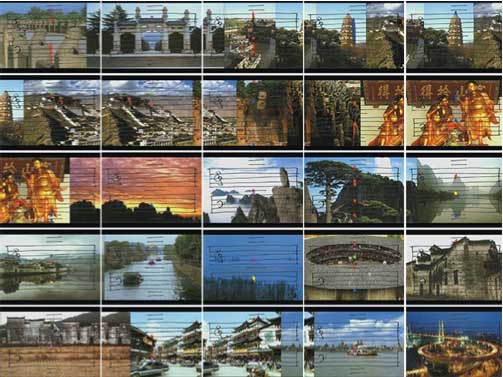
Hu Jieming (b. 1957, Shanghai) is one of the foremost pioneers of digital media and visual installation art in China, and a professor at the Shanghai Institute of Visual Arts. Hu graduated from the Fine Arts Department of the Shanghai Light Industry College in 1984. Since the 1980s he has used emerging technologies to create works which deconstruct time, historical strata and contemporary elements of Chinese culture. One of his main focuses is the simultaneity of the old and the new: a theme that he constantly questions in a variety of media ranging from photography, video works and digital interactive technology in juxtaposition with musical comments. Through his work, Hu strives to reveal the interconnected nature of the digital universe, imagining, as he describes it, “a kind of socialism of the future”. Hu Jieming is one of the founders of CAC | Chronus Art Center in Shanghai, where he will be exhibiting with renowned media artist, Jeffrey Shaw, concurrently with PANDAMONIUM. Recent exhibitions of his work include a solo-show titled Spectacle at the K11 Art Mall, in Shanghai (2014) and two group exhibitions at ShanghART in Beijing, both in 2014.
Outline Only, 2001
The images in Outline Only originally come from the famous postcard series The Sights of China, in which ‘the most attractive historical spots’ of China are featured. Scanned and processed, Hu has created a 9-minute video from this content. In it, the images are ‘played’ as they run sideways across the screen’s drawn-on musical staves. When positioned in the centre of the screen, coloured strokes on the staves trace the outline of the depicted cultural monuments and natural sights, thereby composing the music. Outline Only is an early work from a series of work Hu Jieming continues to this day, enacting digital manipulations on the static surfaces of historical views.

Hu Weiyi (b. 1990, Shanghai) is the son of Hu Jieming and now continuing his studies as a graduate student of Zhang Peili at the Media Department of the China Academy of Art, after having graduated from the Department of Public Art at the China Academy of Art in 2012. Hu is a multimedia artist and curator, whose work combines video, installation, sculpture, action, and sound. In 2012 he curated a young artists exhibition titled The Bad Land, in which the occupation of a public crossroad in Shanghai functioned to address the limits between art and life, public and private. Recent exhibitions include The Overlapping Reflection at the 2nd Zhujiajiao Contemporary Art Exhibition in Shanghai and The Summer Session at V2 in Rotterdam, both in 2013. His work will be shown in Berlin for the first time.
Keep Crawling, 2012
Video-performance Keep Crawling can be similarly seen as addressing a specific condition of contemporary life in China. Toy ‘crawling’ mechanic soldiers are dispatched on a crossroad, crawling their way between the wheels of moving cars passing by. Some ‘survive’ while others are mercilessly crushed by car tires. A few are actually salvaged by people passing or driving by. One again, it can be read as the pressure felt by Chinese today — you must keep crawling on, no matter what the circumstances, even though you know, you may be crushed at random, without any predictable logic or justification.
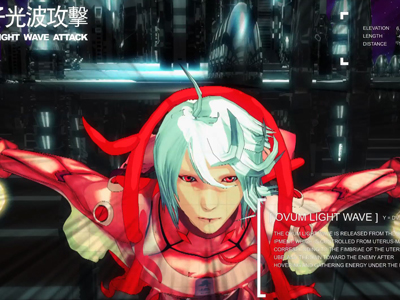
Lu Yang (b. 1984, Shanghai) holds a Master’s degree from the New Media Department of the China Academy of Art in Hangzhou, having studied under Zhang Peili. Her experimental multimedia work uses video, 3D animation, scientific drawings, illustrations and installations to address topics related to science and technology, biology, religion and psychology and most notably to comment on issues of control in modern society. Her shocking combinations of grotesque imagery and deadpan instruction-manuals have made her the most controversial young Chinese multimedia artist of her generation. Recent exhibitions include various solo-shows such as the recent KIMOKAWA Cancer Baby at Ren Space in Shanghai (2014), and a group exhibition ASVOFF – A Shaded View on Fashion Film at the Centre Pompidou in Paris (2013).
Uterus Man, 2013
This androgynous superhero fights to save a future world from an evolution crisis, armed with genetic engineering and hereditary disease. Based on the form of a uterus – strikingly similar to that of a human figure – Lu remarks on its ambiguous gender: he “may look like a man, but the source of his powers actually springs from the generative capability that belongs to a woman. This is an ironic design that sort of satirizes and questions the principle of biological reproduction in our world”. Since its conception, Uterus Man has been released as 3D animation, online game and other open-source collaborations.
The Beast: Tribute to Neon Genesis Evengelion, 2012
Lu Yang’s focus on issues of control leads her to delve into a human conundrum: in view of their inability to escape their physiological realities, her figures use their bodies to create external devices that enable them to break free from their lim itations, while at the same time becoming subjected to the control of their physical form or illness. The Beast is based on the infamous Japanese Manga figure called Neon Genesis Evangelion, with costumes by Givenchy and music by New York based composer and performance artist Du Yun.

Qiu Anxiong (b. 1972, Chengdu) was born in the capital of Sichuan province in the southwest of China. There, he studied under the progressive artistic practice of Ye Yongqing and Zhang Xiaogang. Qiu and his friends collectively founded a bar which became a hub for the blossoming underground music and art circles in Sichuan, and his colleagues included He Duoling, Zhou Chunya, and Shen Xiaotong. In his animated films, Qiu co-mingles the classical and the contemporary, using the traditional Chinese ink-and-wash style to transpose contemporary social and environmental issues onto traditional Chinese landscapes. Qiu has exhibited broadly internationally, having studied contemporary international art and traditional Chinese culture at the Kunsthochschule Kassel, Germany. In 2004 he began teaching at Shanghai Normal University and currently lives and works in Shanghai. Qiu received the Chinese Contemporary Art Award in 2006 and has exhibited widely, including a recent solo-show, titled Qiu Anxiong, The New Book of Mountains and Seas II at the Arken Museum of Modern Art in Ishøj, Denmark (2013) and group exhibition ‘Ink Art’ at the Metropolitan Museum of Art in New York (2013). He is one of the artists undertaking the PANDAMONIUM Residency, and will be producing new work for this show.
Cake, 2014
After working predominantly in oil painting during his studies in Kassel and having later turned to landscape painting in the tradition of the old Chinese masters, Qiu’s return to Shanghai in 2004 marked a shift in interest towards video art. Marked by the same quiet detachment and timelessness as his previous works, but now combining painting, drawing and clay in his animations, Cake offers an exquisitely crafted contemplation on the past, the present, and the relation¬ship between the two.
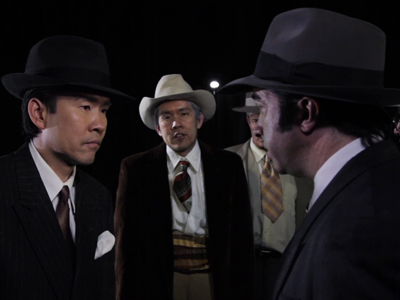
Ming Wong (b. 1971, Singapore) lives and works in Berlin. He graduated from the Nanyang Chinese Academy of Art in Singapore and in Fine Art Media from the Slade School of Art, University College in London. Ming’s unique style of performance-videos explores language and identity, creating his own form of ‘world cinema’. Inspired by iconic works of cinema, as divergent as Rainer Werner Fassbinder, Roman Polanski and legendary Malay entertainer P. Ramlees, Ming creates an ‘everyday life cinema’, creating a stage on which to explore gender-issues and the politics of representation. In most of his work, Ming plays all of the characters himself, regardless of their sex. Ming was awarded Special Mention for his contribution to the Singapore Pavilion at the 2009 Venice Biennale. He has recently received a solo-exhibition, titled Bülent Wongsoy: Biji Diva! at carlier I gebauer in Berlin (2014) and will receive his first museum solo show in China at the Minsheng Museum of Art in Shanghai (2014).
Making Chinatown (Part VII), 2012
For this exhibition Ming Wong is showing one excerpt from his multi channel video installation Making Chinatown (2012), which centers around the making of Roman Polanski’s seminal 1974 film Chinatown. This was the artist’s first project focused on the American context of filmmaking, and was shot entirely in Los Angeles with a local crew. In this final iconic scene, we see the artist in the key roles originally played by Jack Nicholson, Faye Dunaway, John Huston and Belinda Palmer – characters who were linked by sex or blood or even both – and at the same time rendering them Chinese – adding a contemporary, ‘incestuous’ twist to the tragic ending and parting quote, “Forget it, Jake – it’s Chinatown”.
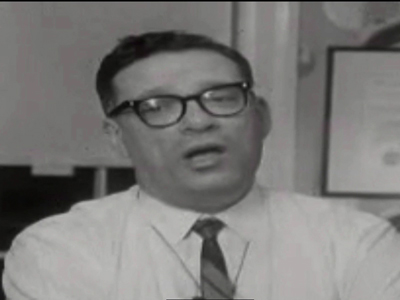
Xu Wenkai (Aaajiao) (b. 1984, Xi’an) is one of China’s foremost media artists, bloggers and free culture developers. Having studied physics and computers, Xu Wenkai is self-taught as an artist and new media entrepreneur. In his works he focuses on the use of data and its various forms of display. In 2003 he established the sound art website cornersound.com and in 2006 he founded the Chinese take on the blog We Make Money Not Art: We Need Money Not Art. He is devoted to Processing, an open-source visual programming software, Dorkbot, a non-profit initiative for creative minds and Eventstructure, an interdisciplinary center for art, media, technology and academic research based in Shanghai and founded by Xu. In his works, Aaajiao focuses on the use of data and its various forms of display and on the processes of transforming content from reality to data and back again. His most significant contribution to the field of new media in China is a social one, as he act a as a vector for the interpretation and communication of international and local trends in the artistic use of software. Recent exhibitions include his solo-show titled The Screen generation, at C Space (2013) and chi K11 Art Space in Shanghai and at 9m2 Museum in Beijing (2014) and group-exhibition TRANSCIENCE – INTRACTABLE OBJECTS at Taikang Space in Beijing (2014). Xu is one of the artists undertaking the PANDAMONIUM Residency.
Hard, 2013
Sampling science-fiction author Isaac Asimov’s explanation of The Three Laws of Robotics (originally published in his 1942 short story Runaround), Xu applies profanity delay – a digital delay technique often used for live broadcasts to prevent unwanted profanity – to destroy or re cycle the footage. The resulting inconsistencies in Asimov’s robot-theory are thereby generated through technological interferences.
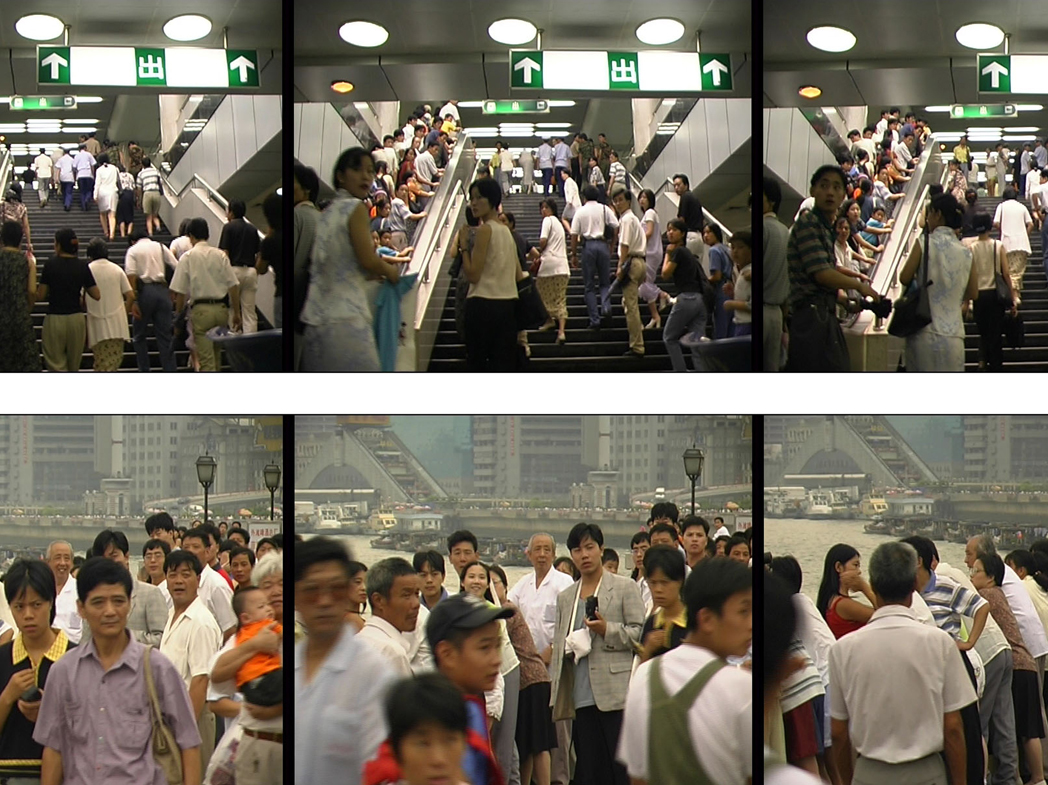
Xu Zhen (b. 1977, Shanghai) is a trans-medial conceptual artist based in Shanghai. Incorporating painting, installation, video, photography performance and even extending into curatorial practice, Xu’s work satirizes, exposes and reworks dominant rhetoric of the contemporary art-world. Currently working under his company name MadeIn Inc, a self-declared ‘multi-functional art company’, he appropriates the art-as-brand discourse to criticize it from within. A jester at heart, he plays on authorial conventions and expectations, creating pseudo-fictions replete with cultural clichés, wittingly challenging the pervasive longing for clearly delineated so-called cultural authenticity. An irreverent artist with a unique ability to produce work across multiple platforms and media, Xu Zhen is the key figure of the Shanghai art scene and a foundational figure for the generations of Chinese artists born since 1970. Xu’s practice reflects the lingering concerns of an artist participating in the international art world while remaining deeply sceptical of it and its conventions, most immediately the label ‘Chinese contemporary art’. Working in his own name since the late 1990s, Xu Zhen is now producing new works under MadeIn Company’s newly launched brand ‘Xu Zhen’. Recent major exhibitions include his retrospective, Xu Zhen: A MadeIn Company Production, at Ullens Center for Contemporary Art in Beijing (2014) and his Commissioned Artist exhibition at the Armory Show in New York (2014).
Shouting, 1998
Moving crowds go about their regular and routinized business of commuting until suddenly startled by distressing screams behind them. They all turn their heads simultaneously to determine the cause of the cries, thereby engendering both a synchronized movement that is atypical of such street-scenes, as well as laughter from whoever is behind the camera.
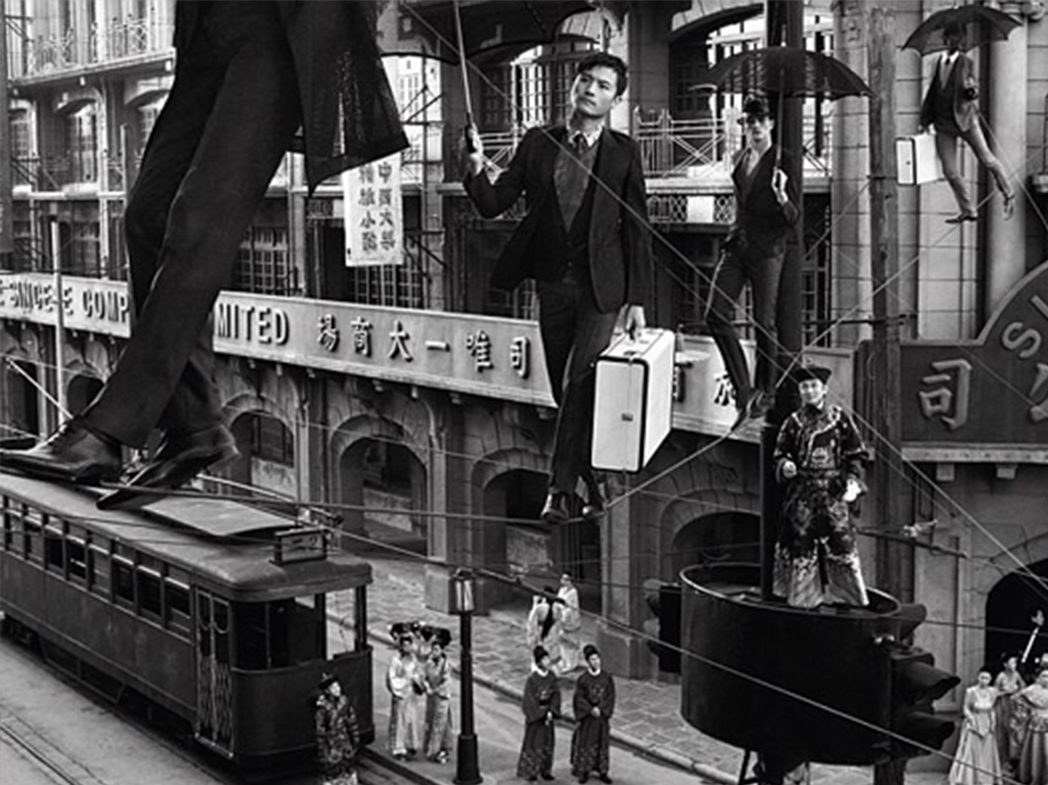
Yang Fudong (b. 1971, Beijing) is considered to be one of China’s most well-known cinematographer and photographer and one of the brightest young stars in China and the greatest film writer ever to come out of China. When creating his narrative films, he portrays that anything is possible, including fantasies and dreams. There are different themes surrounding Yang’s films, but they all have a purpose, theological or literal. He is considered one of the deepest cinematographers in the world because of the time and passions he puts into each of his works. Yang Fudong’s most popular works include: Seven Intellectuals in a Bamboo Forrest, The Fifth Night, the 17th Biennale of Sydney, East of Que Village, An Estranged Paradise, Backyard- Hey! Sun is Rising, and No Snow on the Broken Bridge. Yang continues to live and work on his films in Shanghai. As a successful filmmaker he is constantly traveling around, attending his premiers and other prestigious international art events. There are viewings of his movies in Europe, North America, and Asia. Yang Fudong does not show much interest in showing a strong political interest in his films, there are slight implications of his opinions but mostly he focuses on the interactions between different individuals.
City Light, 2000
Yang regularly makes use of traditional film genres and City Light is no exception. In a style that references detective- and slapstick-movies, a young, well-dressed office clerk and his doppelgänger move in unison along the street and around the office. Like pre-programmed robots they fit perfectly into their apparently ideally organised environment. The day is entirely dominated by work, but the evening provides space for dreams and creative thinking, causing a schizophrenic situation to arise. In their heroic conduct the two gentlemen sometimes develop into two gangsters who engage in a form of shadowboxing.
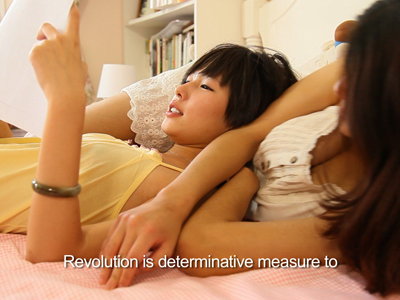
Yang Zhenzhong (b. 1968, Hangzhou) graduated in oil painting from the China Academy of Art and started working with video and photography in 1995. Early in his career he worked with Yang Fudong and Xu Zhen and extended his practice into the field of curating since the late 1990’s. His work is marked by a rebellious though humorous sarcasm. Rather than directly answer existing questions on Chinese art via any particular art form or language, he and his colleagues prefer a freer, more open and tolerant attitude, which has placed them in the limelight and on the international art-stage. Yang’s practice is informed by the desire to challenge normative notions of social behavior, as well as an ongoing preoccupation with China’s intrinsic disharmony and severe social contrasts. Recent shows include solo-exhibitions Trespassing at OCT Contemporary Art Terminal in Shanghai (2013) and Passage at TOP Creative Park in Shanghai (2012).
Exam, 2012
In the video two girls rehearse the content of Marxist texts and other classics of socialism in the cosy atmosphere of their room: the patent discrepancy between the content and the context produces a sort of revelation effect. We don’t know exactly what is being revealed to us, but we may guess it’s something about social, political and cultural hypocrisy. The voyeurism of the camera as it lingers on the uncovered parts of the girls’ bodies, reveals the coexistence of collectively shared beliefs and massively hidden pleasures all the more effectively.
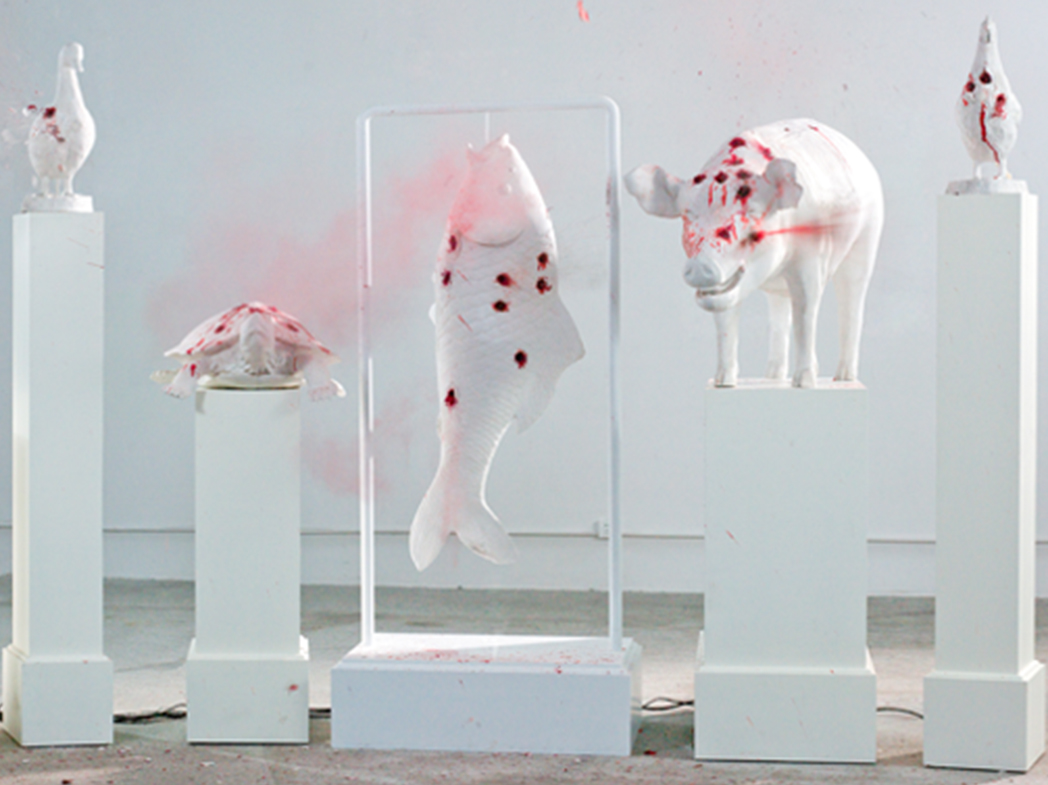
Zhang Ding (b. 1980, Gansu) is a rising star of Chinese multimedia art. He first studied at the North West Minority University in the Oil Painting Department and went on to study under Zhang Peili in the New Media Arts Department at the China Academy of Fine Arts. Zhang works with large-scale mixed-media installations, incorporating video, performance and interactive components. He is influenced by the fantastical style of Italian filmmaker Federico Fellini and explores ethnic tensions, the plight of migrant workers, and the marginal urban cultures that lurk in the recesses of Chinese society. He has exhibited internationally at major institutions and has had international solo shows including Orbit at The Armony Show, Focus Section, in New York (2014) and Gold and Silver at Galerie Krinzinger in Vienna (2013), but has never before been shown in Berlin.
Buddha Jumps over the Wall, 2012
The culinary dish called Buddha Jumps over the Wall – a variety of shark fin soup – is regarded as a Chinese delicacy and so much so that it is said to even entice the vegetarian monks from their temples to partake in the meat-based dish, hence its name. In allusion to this dish, Zhang’s video features a group of animal plas ter-sculptures that are individually shot at and finally exploded altogether, to shatter into pieces. Accompanied by a magnificent and solemn symphony and filmed by means of a high-speed camera lens that captures every detail, we see bloodlike liquid and shards of debris flying everywhere in a shocking and cruel, though undeniably aesthetic manner.

Zhang Peili (b. 1957, Hangzhou) is the dean of the New Media Department at the China Academy of Fine Arts and is widely considered to be the ‘father of video art in China’. Indeed it is no coincidence that he has taught many of the younger artists in this show. PANDAMONIUM revisits his classic work, Hygiene #3, first shown in Berlin in 1993 in ‘China Avant-Garde’ at the Haus der Kulturen der Welt. 20 years later, MOMENTUM re-presents this work in the context of the younger generation of artists that has been influenced by Zhang’s groundbreaking practice. Hygiene #3 was the first Chinese installation-work to be acquired by MoMA, New York and is also included in the collection of Fukuoka Asian Art Museum, Japan, and the Ullens Center for Contemporary Art, Beijing. Zhang’s work has recently been shown in a solo-exhibition at the Jack Tilton Gallery in New York (1999), as well as in notable group-shows such as China Now at MoMA, New York (2004) and Beyond Boundaries at the Shanghai Gallery of Art (2004).
Document on “Document on Hygiene” No.3, 1991
This vid eo was recorded in a class room at Hangzhou University of Art and Design with art teacher Li Jian as the cameraman. It cap tures a person bathing a live chicken with soap and water for 150 minutes until the video tape runs out, at which point the chicken is covered in a thick, soapy fleece. The vid eo was edited down to 24 minutes 45 seconds and the sound was removed. Shot at the time of China’s wide-spread and hard-handedly censured influenza epidemic – predominantly spread through chicken-meat – the apparent absurdity of this act subsides. At the time, it was banned from exhibition venues, and was shown only in underground semi-private art happenings.
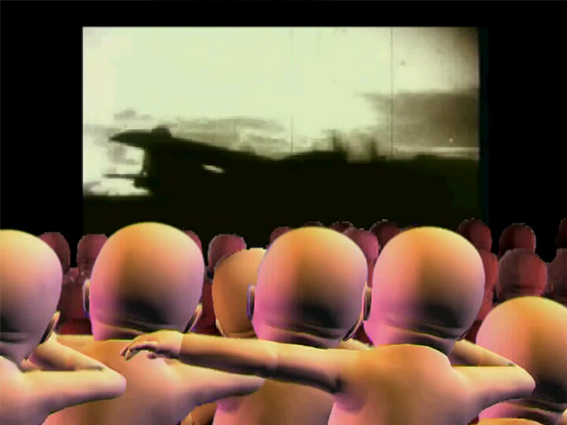
Zhou Xiaohu (b. 1960, Changzhou) is a pioneer of video animation in China and one of the first artists to work sculpturally with this medium. Although originally trained as an oil painter, he began using computers as an artistic tool in 1997. He is a great-nephew of Zhou Enlai, the first premier of the People’s Republic, who is said to have had a predictive eye by remarking that “this kid’s going to lead everyone astray”, when Zhou was aged only five. As one of China’s most well-known most prolific contemporary artists, he specializes in inducing confusion and bafflement, making viewers question the evidence of their senses and their assumptions about the so-called ‘facts’. He has since experimented with stop-frame video animation, video installation and computer-gaming software, whereby the interlayering of images between moving pictures and real objects has become his signature style. Working across performance, photography, installation, sculpture, video, and animation, Zhou’s practice reflects the documentation of history in a digital age, where particular details become privileged, fabricated, altered, and/or omitted. Zhou’s recent shows include his participation in Tate Liverpool’s The Real Thing: Contemporary Art from China (2007) and solo-exhibitions at Long March Space in Beijing (2009-10) and at BizArt Center in Shanghai.
Beautiful Cloud, 2001
Beautiful Cloud shows masses of disturbing puppet-like cloned babies, who collectively watch found footage of the most famous cruelties of the human race on the big screen and see the atomic mushroom as ‘a beautiful cloud’. They all jointly swing to the tune of Zuoxiao Zuzhou’s song, whose starting lines can be translated as: “Put your 3-pin plug into your mouth, my darling, you can find my heartbeat is accelerating”.
ABOUT THE CURATORS
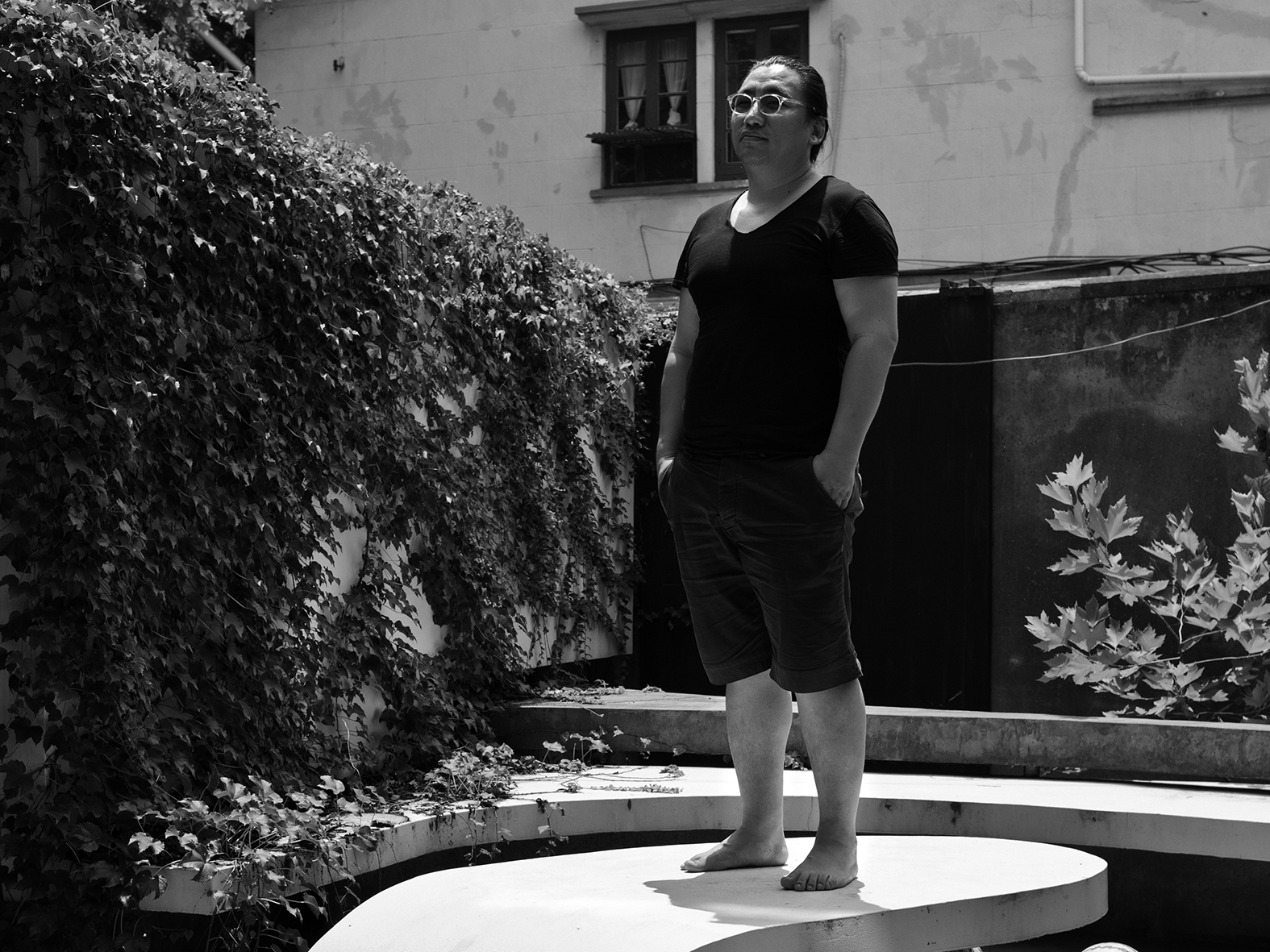
Li Zhenhua has been active in the artistic field since 1996, his practice mainly concerning curation, art creation and project management. Since 2010 he has been the nominator for the Summer Academy at the Zentrum Paul Klee Bern (Switzerland), as well as for The Prix Pictet (Switzerland). He is a member of the international advisory board for the exhibition “Digital Revolution” to be held at the Barbican Centre in the UK in 2014. Li Zhenhua has edited several artists’ publications, including “Yan Lei: What I Like to Do” (Documenta, 2012), “Hu Jieming: One Hundred Years in One Minute” (2010), “Feng Mengbo: Journey to the West” (2010), and “Yang Fudong: Dawn Mist, Separation Faith” (2009). A collection of his art reviews has been published under the title “Text” in 2013. http://www.bjartlab.com | http://www.msgproduction.com
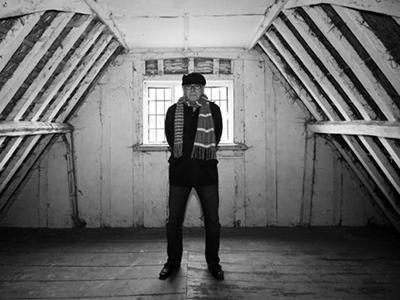
DAVID ELLIOTT
David Elliott is an English born curator and writer. From 1976 to 1996 he was Director of the Museum of Modern Art in Oxford, England, Director of Moderna Museet [The National Museum of Modern and Contemporary Art] in Stockholm, Sweden (1996-2001), founding Director of the Mori Art Museum in Tokyo (2001-2006), the first Director of the Istanbul Museum of Modern Art [Istanbul Modern] (2007), Artistic Director of the 17th Biennale of Sydney (2008 – 2010) and Artistic Director of the 1st Kiev International Biennale of Contemporary Art (2011-12), Artistic Director of the 4th International Biennale of Work by Young Artists in Moscow (2014-2014), Rudolf Arnheim Guest Professor in Art History at the Humboldt University, Berlin (2008) and Visiting Professor in Museum Studies at the Chinese University in Hong Kong (2008/11/13). From 1998 until 2004 he was President of CIMAM (the International Committee of ICOM for Museums of Modern Art). He is Hon President of the Board of Triangle Art Network/Gasworks in London and on the Asia Advisory Board of the Guggenheim Museum in New York.
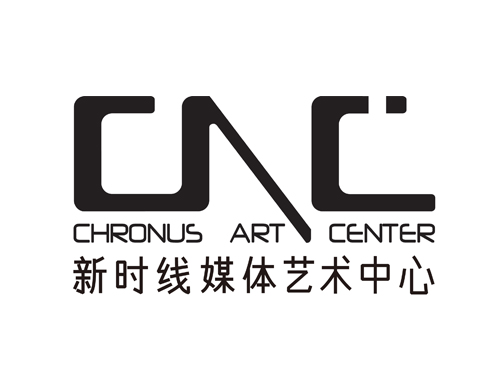
ABOUT CAC | CHRONUS ART CENTER:
Founded in 2013, CAC | Chronus Art Center is the first major non-profit art organization in China focusing on the experiment, production, research, exhibition and education in new media art. Having traveled MOMENTUM’s exhibition The Best of Times, The Worst of Times Revisited to CAC Shanghai in the first months of 2014, we continue our collaboration in Berlin with a 4-month program of Chinese media art presented by CAC and MOMENTUM.
Presented by MOMENTUM and CAC | CHRONUS ART CENTER in partnership with:
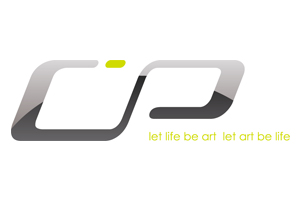
April 3 – July 7: Ai Weiwei EVIDENCE at Martin-Gropius-Bau
April 29 – July 13: PANDAMONIUM Partner Exhibition 8 Of Paths: New Positions in the Beijing Art Scene, curated by Guo Xiaoyan, Thomas Eller, Andreas Schmid
May 2 – 4: Gallery Weekend
May 29 – August 3: Berlin Biennale
May 1 – May 31: Month of Performance Art Berlin (MPA-B)
[fve] http://player.vimeo.com/video/95589876 [/fve]
PANDAMONIUM Opening Photo Gallery:
PAMDAMONIUM Finissage Photo Gallery:


 Back to Homepage
Back to Homepage






